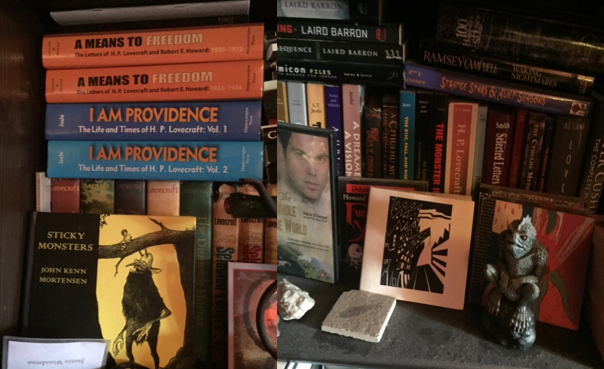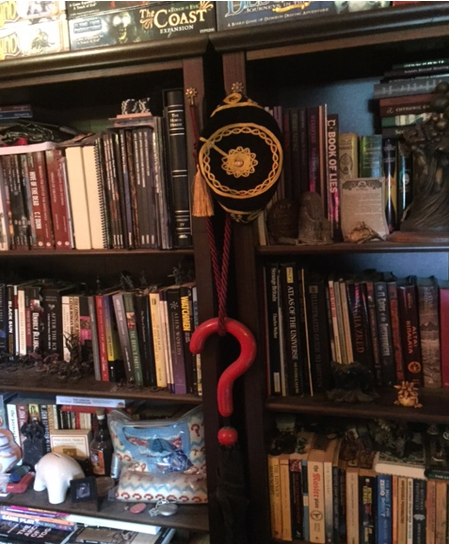Dr Justin Woodman studied at Goldsmiths where he completed his doctoral research on concept and the politics of the ‘demonic’ within contemporary occultures in the UK. Current research interests include – esotericism, speculative fiction and popular culture; racism and political extremism within cultures of conspiracy; religion, cognition and the ‘New Atheism’.
Justin kindly sent of photographs of his bookshelves from his home.

Linford Superville: Have you changed your bookshelf for this interview, if so – why Justin?
Justin Woodman: Did you see the amount of dust on the shelves? [This is met with lots of laughter]. I have some work going on at the moment, so I haven’t bothered dusting, I may have re-arranged some of the books so that you could get a better view, but other than that, no.
Linford: Do you organise your books?
Justin: There’s a very rough system, I have one large block of shelves which is largely dedicated to HP Lovecraft related stuff. There are some bottom shelves that are related to my gaming activities. Otherwise, not really – its just where I can find space to put them. A broad organisation, but nothing systematic.
Kaytrina Falcini: I’m very interested in the book-ends and other pieces on the shelves. Have you always had those?
Justin: Yes. It’s more about creating a kind of mood. It’s where I do most of my work, and writing – particularly if I’m doing work that’s a bit more creative. It’s about creating the right ambience; I was going for was Victorian style bookshelves with lots of old artefacts and things hanging round on them.

Linford: Where do your books come from, and how do they leave?
Kaytrina: So, do you donate them, or would you donate them – or are you very precious about them?
Justin: I do tend to be quite precious about them. I do have a number of boxes in my attic which contain a number of books which are no longer things that I need to reference or make use of. Usually what I do when I get rid of them, is to give them away to friends. I certainly think about donating them, but people generally take them off my hands. With some very expensive books, I will put them on eBay and use the money to buy more books.
What I did one year, when meeting with friends (that are interested in the same things as I am) at Christmas time, was to just wrap up about 30 books, which they randomly picked, and were able to swap with each other, to keep.
Linford: So when you give to friends is it because you think they may be interested in the subject, or for birthdays?
Justin: Usually if I think they’d be interested in the subject.
Linford: What was you first anthropological book?
Justin: There were two, really. One was Ritual Cosmos by Evan Zuesse – which was one of the first books I read at university, it’s about African religious systems. The other, was the classic Witchcraft, Oracles and Magic Among the Azande by Evans-Pritchard; I think that was the one that really turned me on to anthropology. I was really interested in ideas around magic and witchcraft – I took them really seriously rather than to think that this was just an irrational belief.
Linford: So Evans-Pritchard inspired you?
Justin: Yes, definitely. Both books but more so the Evans-Pritchard. I owned the Evans-Pritchard one before I did the Zuesse.
Linford: Which is your least favourite book and why?
Justin: Um… the immediate answer that has come into my head is Clifford Geertz, Interpretation of Cultures. From an anthropological standpoint, whilst it’s a classic, I find it a really dry read. It’s an important book, but I just don’t like reading him.
Linford: Did you have any books with you in the field, if so which ones, and why?
Justin: Actually, it was a bit different for me; I did my fieldwork in London, I was working from home, so I had all of my books with me. So – yes, all of them.
Theoretically, had I been in that situation – I don’t think I would have taken any anthropology books with me, I would have taken books purely for relaxation. I probably would have taken the collected fiction of HP Lovecraft and the collected poetry of HP Lovecraft. Possibly my favourite book, which is incredibly difficult to get hold of these days – the Readers Digest Guide to Myth and Folklore, among certain groups it’s a rarity and collectors item. It’s written in the 1970’s and it goes through the British Isles and details folklore and ghost stories, supernatural beliefs – it’s a really fascinating read

Kaytrina: So, do you actually own a lot of rare books?
Justin: Not as many as I used to, due to the digital revolution; I probably have about 30 or so that are in the price range of £100 +. I don’t think I own anything that is more than £150 these days. I did have a few fairly expensive books that went for £300 – £350. In one of the areas I work in there something called Talismanic books, which is a movement where small publishers publish very limited runs. Sometimes only 20 or 30, leather bound high quality books; I bought a few of those related to my research, but I’ve sold those now. Also as things become digitised I tend to sell the more expensive versions and buy kindle or ebook versions. I do like physical product, but I’m not kind of married to that idea, I’d rather spend money on buying more books. I fold back pages and underline and write in my books; not the really expensive ones. But generally, they’re artefacts.
Linford: Are there any books that you have been given by a fellow anthropologist that you would not part with?
Justin: No (laughing) I would rather pass them on to someone else so they can mine the knowledge.
Linford: Best non anthropological book and why?
Justin: I’ve already mentioned that one, the Readers Digest Myth and Folklore. It’s one you can dip into now and again. Also it’s a bit of a nostalgia for me. It came out in the 70’s and it reminds me of Britain in the 1970’s. It reminds me of my childhood, and something I’m involved in today, the Folk-Horror Revival; a movement looking at literature and film that appeared in the 70’s. Key example of this is a film called The Wicker Man. Folk Horror is a conflict between modernity and the tradition. In the 70’s there were so many children’s programmes like this, quite horrifying ones that would have been censored today by the BBC. This was how I first became interested in supernatural literature and magic and esotericism.
Also a book called The Ancient Track, the complete poetry of HP Lovecraft which contains The Fungi from Yuggoth 36 sonnets that all relate to each other. That’s my favourite piece by Lovecraft.
Linford: Most underrated book?
Justin: Probably Pascal Boyer – Religion Explained. It’s a very readable book and offers an understanding about cognitive anthropology and its response to religion; why we have it, why it’s important; how evolutionary pressures have shaped the way we think. I do think that anthropology rejects that, at its peril. Aspects of human behaviour are not predetermined. It’s not a book that rejects religion, it says that religion is a natural thing, this is why I think more people need to read it.
Linford: Can you tell us a little about the non-book items on your shelf?
Justin: There are the Lovecraft related items, the statues – most of these come from people personally known to me. I have bought a lot of items from an American artist called Gage Prentiss. All these things create a kind of ambience in terms of HP Lovecraft and some of the creative writing, like the daily blog that I write. These are material objects that are tied to social relationships that I have. “It’s about creating that kind of mood, darkness, despair and nihilism” [met with much laughter]. I am also a huge Dr. Who fan, with Sylvester McCoy as my favourite. The first thing that terrified me as a child was watching an episode of Dr. Who, with Jon Pertwee, as the doctor. It was in 4-parts, called the Green Death and was about huge green maggots, covered in slime- if the slime touched you, it killed you and also turned you green; I was terrified, but I love being terrified. Dr Who of the 70’s and 80’s was actually quite horrifying. For some reason, I decided I wanted to get the Dr Who umbrella that has the question mark. I also have the Sylvester McCoy tank top [more laughter].
Kaytrina: I’ve never seen you wear it!

Kaytrina: What do you think is the difference between your bookshelves and those of other anthropologists?
Justin: Just about everything? One of the things that aren’t visible on my shelves are anthropology books. They are dotted around and also some are stored in a cupboard.The shelves I have here (his office at Goldsmiths University), are not organised, some books have been given to me by the people in the department, some I’ve brought in and have not taken them back, this really just storage space.
Linford: What do you like, and not like, about your bookshelf?
Justin: Not having more shelves, more space. It is cramped. But, if I had more shelves, I would just fill them up.
Linford: Final question, which book would you recommend that everyone should read?
Justin: I think I have to go back to Religion Explained, by Pascal Boyer. For me, it was an eye opener, I was seeking to understand how we could think about religion from a “scientific” viewpoint, and that was the book that began to provide the answers for me.

Justin Woodman was interviewed by Linford Superville and Kaytrina Falcini.


Leave a comment